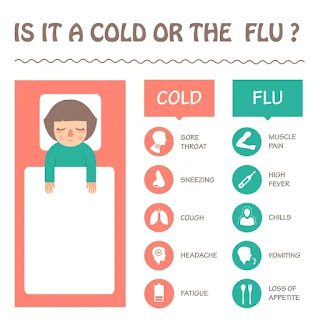Common Cold And Flu
Do you know the difference between the common cold and the flu?
The common cold and flu are two of the most common illnesses that people experience, particularly during the winter months. They share many similar symptoms, making it difficult to tell them apart. In this blog post, we will discuss the common cold and flu, their causes, symptoms, treatment, and prevention.
Causes
The common cold and flu are caused by viruses. The cold is caused by the rhinovirus, while the flu is caused by the influenza virus. Both viruses are highly contagious and can spread easily from person to person through coughing, sneezing, or touching contaminated surfaces.
Symptoms
The symptoms of the common cold and flu are similar and can include:
Common cold symptoms:
- Runny or stuffy nose
- Sore throat
- Cough
- Sneezing
- Watery eyes
- Mild body aches
- Mild headache
- Low-grade fever (less than 100.4°F or 38°C
Flu symptoms:
- High fever (usually above 100.4°F or 38°C)
- Chills and sweats
- Body aches and muscle pain
- Fatigue and weakness
- Headache
- Dry cough
- Sore throat
- Nasal congestion
- Nausea, vomiting, and/or diarrhea
the flu tends to have more severe symptoms than the common cold.
Treatment
There is no cure for the common cold or flu. Treatment focuses on managing the symptoms and supporting the immune system. Over-the-counter medications can help relieve symptoms such as fever, cough, and congestion. Rest, hydration and a healthy diet can also help the body fight the virus.
Prevention
Practicing good hygiene is the best way to prevent the common cold and flu. This includes washing your hands regularly, covering your mouth when you cough or sneeze, and avoiding close contact with people who are sick. Getting a flu vaccine every year can also help prevent the flu. The vaccine is designed to protect against the strains of the virus that are most likely to circulate each year.
Conclusion
The common cold and flu are two viral illnesses that are prevalent during the winter months. While they share similar symptoms, the flu tends to be more severe. There is no cure for either illness, but treatment focuses on managing the symptoms and supporting the immune system. Good hygiene and getting a flu vaccine can help prevent the spread of these viruses.









